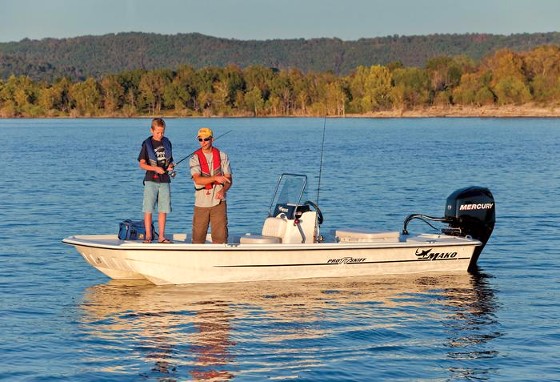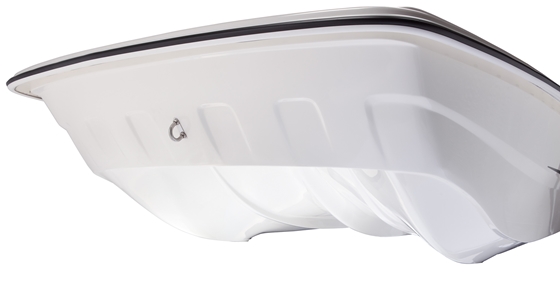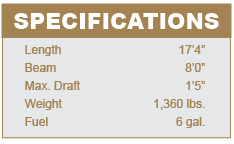1995 Kenner Pro Skiff Tunnel Hull Boat Reviews
Mako Pro Skiff 17 Center Console: A Hull New Innovation
Mako Boats has fabricated a major divergence from the norm with their new line of skiffs, epitomized past this 17-foot model.
The Pro Skiff 17 Middle Console is one of several new Mako models—xvi- and 17-foot hulls bachelor in both tiller-steered and heart-console versions. So what's the big surprise? Just stretch out on the bow, hang your head over the rubrail, and take a gander beneath the waterline. This is no flat-lesser skiff, nor is it a semi-V or V-hull. In fact, it looks downright true cat-like, although Mako calls this an "advanced inverted V hull" design. We call it so darn skillful, it helps this boat brand our listing of the Top 10 Fishing Boats of 2012.

What the heck is an inverted V? That depends on who you ask - the term has been practical to many hull shapes, most of which prevarication somewhere betwixt tunnel hulls and catamarans. In the Mako'southward example, the hull looks more or less like a true cat with a relatively narrow tunnel that has a tertiary smaller 5 running downwardly the heart. It'south complemented past two more mini-V'south, 1 to either side of the V in the center. These 2 smaller features look nigh similar vertical chines, and much like a chine, these surfaces are intended to direct h2o. Unlike a chine, they're intended to direct water that's below the waterline, not flying upwards or away from it. Instead, they help direct the turbulent water created in the tunnel away from the prop, and feed "solid" water to it, preventing the ventilation bug that are common to many cats and tunnel boats that run on a unmarried spiral. And they practise their task well: While I was running the 17 across Tabular array Rock Lake, moving ridge-hopping off of boat wakes and charging through a 1-foot chop, the prop didn't lose its bite a single time.

The Mako Inverted V includes characteristics of both power cats and V-hulls.
When you run a Pro Skiff 17 CC it'll immediately become apparent why Mako went to all the problem of designing this relatively complex lesser for a small, relatively inexpensive model line: the ride is aught short of stellar. Much similar a cat, the tunnel compresses an air/water slurry in between the two hulls, cushioning impacts and rendering waves powerless. Also like a true cat, handling will accept a trip or ii to get used to. The boat doesn't lean out like some twin-hull fishboats, simply it doesn't bank nearly as much as a V-hull, either. And there's 1 more running characteristic that sets it apart from catamarans: the gunkhole doesn't mind existence loaded downwards with weight. A single rider sitting on the bow tin be enough to cause the painful "tunnel-slap" in many small twin-hulled boats (when the flat surface of the top of the tunnel slams against the water), but perhaps thanks to those extra Vs nether the deck, the Pro Skiff 17 maintains a soft ride even when fully loaded. Performance, meanwhile, is nearly what you'd look from any boat of this size powered with a 60-hp 4-stroke. I saw a 25-mph cruise at 4500 rpm and a 35.iv-mph top-terminate.
Don't let the complexity or the newness of this hull mislead you into thinking that this is an expensive boat. 1 of the best things most information technology, in fact, is the price tag: $xiv,995 will get you the entire package, complete with a trailer. Cull the tiller-steer version with a 25-hp outboard, and the toll-betoken barely breaks $ten,000.
 In that location's only one obvious cost-cutting measure out visible on the Pro Skiff 17 CC -- a console that'due south roto-molded plastic instead of fiberglass. It flexes quite a bit, simply information technology does have an viii-gallon molded-in livewell nether a forward seat, plus five vertical rodholders. The bottom line? If y'all're looking for a new skiff that epitomizes the best attributes of a true cat even so eliminates many of the twin- and tunnel-hull drawbacks, the Pro Skiff 17 CC is a must-encounter.
In that location's only one obvious cost-cutting measure out visible on the Pro Skiff 17 CC -- a console that'due south roto-molded plastic instead of fiberglass. It flexes quite a bit, simply information technology does have an viii-gallon molded-in livewell nether a forward seat, plus five vertical rodholders. The bottom line? If y'all're looking for a new skiff that epitomizes the best attributes of a true cat even so eliminates many of the twin- and tunnel-hull drawbacks, the Pro Skiff 17 CC is a must-encounter.
Other choices along the same lines: The Twin Vee 17 is the closest cat; Carolina Skiff'south 17 is the closest gunkhole with a traditional hull pattern.
For more information, visit Mako Boats.
-Lenny Rudow
Source: https://www.boats.com/reviews/mako-pro-skiff-17-center-console-a-hull-new-innovation/
0 Response to "1995 Kenner Pro Skiff Tunnel Hull Boat Reviews"
Post a Comment